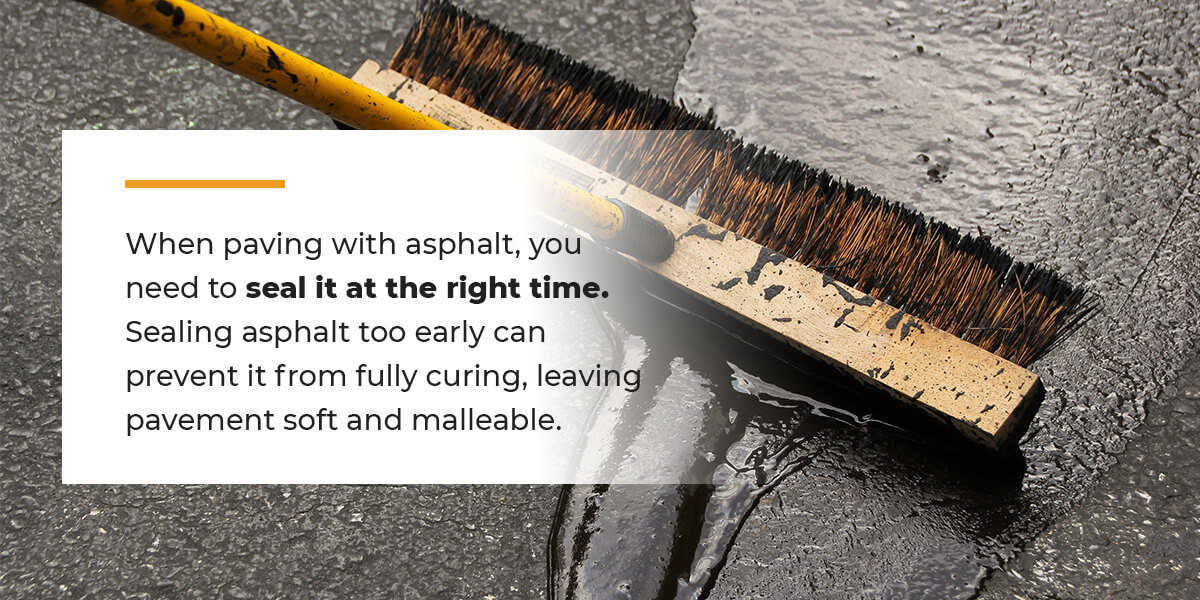
Asphalt is an excellent pavement option for property managers. It’s versatile, allowing you to use it for walkways and parking lots on the properties you manage. Its black color makes it look sleek and professional and parking lines and handicapped spots stand out more against its solid background.
Understanding the timeline for the asphalt installation process can help you better schedule and accommodate tenant needs. Asphalt depends on this process to ensure its quality and durability and following its timeline can help you make the most of your asphalt investment.
How Long Does Asphalt Take to Dry?
Asphalt typically takes around two days to cure. Your location’s weather conditions and patterns can impact its drying and setting time and prevent tenants from accessing the paved sections of the properties for longer periods.
Local climate and seasonality will influence how quickly asphalt dries. Warmer, more humid environments will double the average time required to dry because more moisture will cause the asphalt to soften. In these conditions, you might need around three to four days for the asphalt to dry. Rain can also disrupt the drying process. When planning to repave properties, you can increase your chances of a quick drying time by paving during colder or mild seasons. In Florida, fall and spring are the best times to pave with asphalt.
If you need to use asphalt paving in the summer, you can offset the impacts of heat by watering the pavement on hot days. The cold water can help the asphalt harden when the heat tries to soften it, helping it set faster. However, you should also be aware of paving when it’s too cold. In the winter, asphalt might set and harden before crews finish installing it, leaving it full of bumps. You can only remove these by starting over, making it cost- and time-inefficient.
How Long Before You Can Drive on New Asphalt?
After the first 48 hours of drying, you can allow tenants and their customers to go on asphalt. However, if conditions require more time for the asphalt to dry, you will need to wait with it to ensure its quality and preserve its life span. Pedestrians can typically access fresh pavement before vehicles do because their lower weight has less impact.
You will need to block off freshly paved sections to prevent people from walking or driving on the asphalt while it dries. Vehicles will have to wait longer than pedestrians to access paved areas because their weight can leave dents in asphalt that hasn’t dried yet. To protect a property’s quality and life span, you should wait to let cars and trucks access recently paved asphalt.
To check if the asphalt is dry, you can test it by pouring water on it. If the asphalt absorbs the water, it is still drying and cannot support pedestrians or motorists.
Why Wait for Asphalt to Dry?
While you can drive on fresh asphalt, it needs time to dry before it can handle heavy-duty and long-lasting applications like parking. Vehicles sitting in the same spots for hours every day can leave dents in the asphalt, creating uneven pavement that is challenging to drive on or use.
Heavy trucks and tractor-trailers can also leave tire tracks in uncured asphalt. If a property requires heavy vehicles or traffic while the asphalt dries, you can use plywood to offset the weight and ensure it sets more evenly for safer, higher-quality pavement.
When to Apply Sealcoating to New Asphalt
Sealing asphalt ensures its structural integrity and long life span. Proper sealing can keep moisture out, preventing cracks and potholes that require you to repave sooner. Sealing can ensure that properties look their best by making asphalt more stain-resistant. Because this step helps improve asphalt pavement’s durability, you can reduce maintenance costs by sealing.

When paving with asphalt, you need to seal it at the right time. Sealing asphalt too early can prevent it from fully curing, leaving pavement soft and malleable. Waiting too long can leave it vulnerable to moisture damage, increasing the chances of potholes and cracks forming.
Like the asphalt, a sealcoat needs time to dry before tenants can use the pavement again. Sun can help the sealcoat dry faster, while rainy weather will thin it and prevent it from fully curing. Installing your pavement in spring and sealing it in autumn will help you avoid most of the wettest parts of the year.
While sealing can prevent repaving frequently, you will need to reapply sealcoats regularly to offer continuous protection. You should aim to reseal every three to five years for optimal strength and functionality.
How to Keep Customers Happy Until Asphalt Is Dry
Because paving and sealing take time to dry, you will need to temporarily close the parking lot to protect the asphalt’s quality and visitors’ cars. This process can challenge many property managers, who must determine how to balance regular business operations with essential property maintenance.
Whether you are applying fresh asphalt or a new seal coat, you can keep your properties available with many strategies, including:
- Paving lots in sections: Many organizations choose to pave parking lots and streets in sections, so pavement can cure without eliminating valuable space tenants and their customers need for daily operations. Paving portions can accommodate dry time and customer needs when you want to keep the lot available.
- Marking makeshift handicapped spots: You still need to offer proper accessibility when paving in sections. You can post signs or use paint and chalk to mark where temporary handicapped and van-accessible spaces are while paving, sealing and painting take place.
- Providing alternative parking areas: If you need to pave a large area in one session, you can maintain accessibility for customers and residents by directing them to nearby parking. Whether you’re repaving a commercial or residential lot, communicate with the tenants so they can provide their customers with parking plans and strategies.
- Scheduling after regular hours: While sunlight plays a critical role in sealing, asphalt dries without the sun. Consider paving the lot in the evening to avoid closing it during operating hours. While the pavement will still take a couple of days to dry, you can rely on times when customers won’t need to park there.
Optimizing parking lot availability can maintain a positive customer experience on your properties.
Choose ToriTom Services for Rapid Asphalt Installation and Sealcoating
When you want to pave your properties with asphalt, partnering with the right company can ensure you follow the proper guidelines and schedules for quality pavement. ToriTom Services offers extensive asphalt care to Florida property managers, from asphalt installation and sealcoating to maintenance. Our expertly trained employees will help you understand timelines and navigate challenges for quality services that will result in reliable, durable asphalt pavement.
Contact ToriTom Services online today or call us at 941-932-2593 and get started paving your commercial properties with asphalt.

